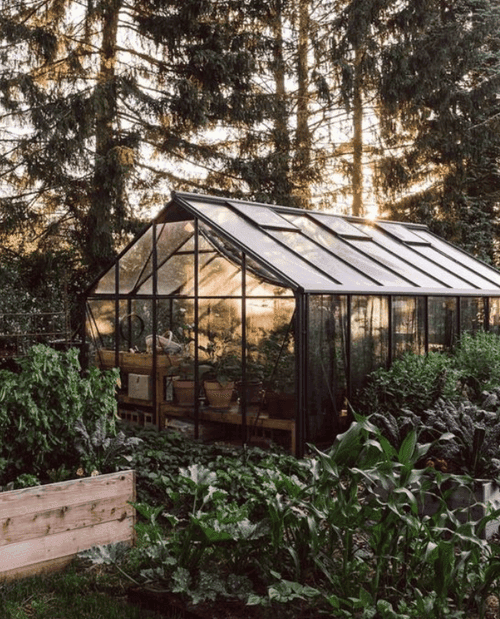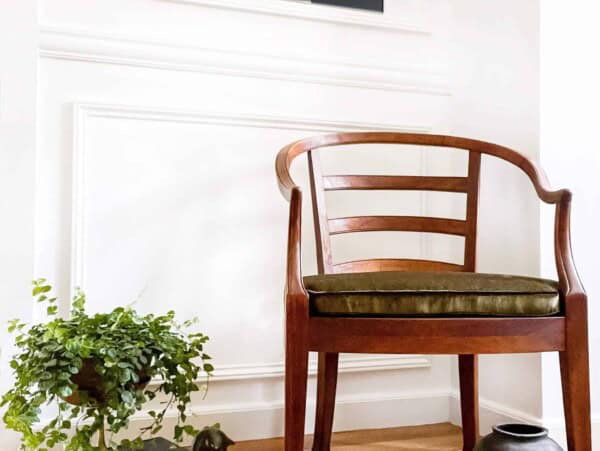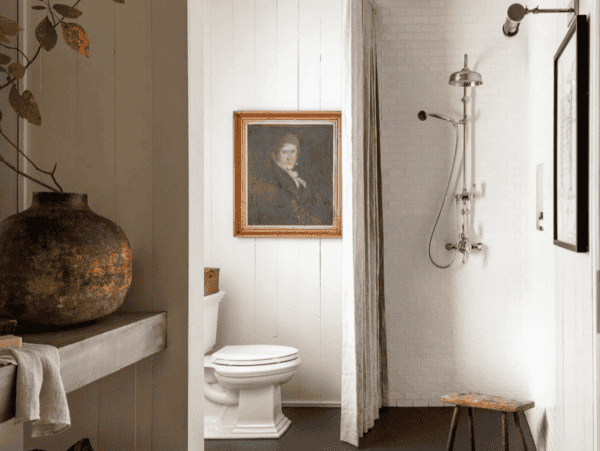Greenhouses are never out of style. Period. Plus, in a modern world, they can be a great way to grow seasonal fruits, and veggies all year long. For me, I just love the art of cultivating something from a seed and watching it grow – especially when we are all at home so much. Some of ya know, I got a greenhouse for my garden. So, I rounded up all the tips and tricks I have learned along the way. Wanna know more? Read on…
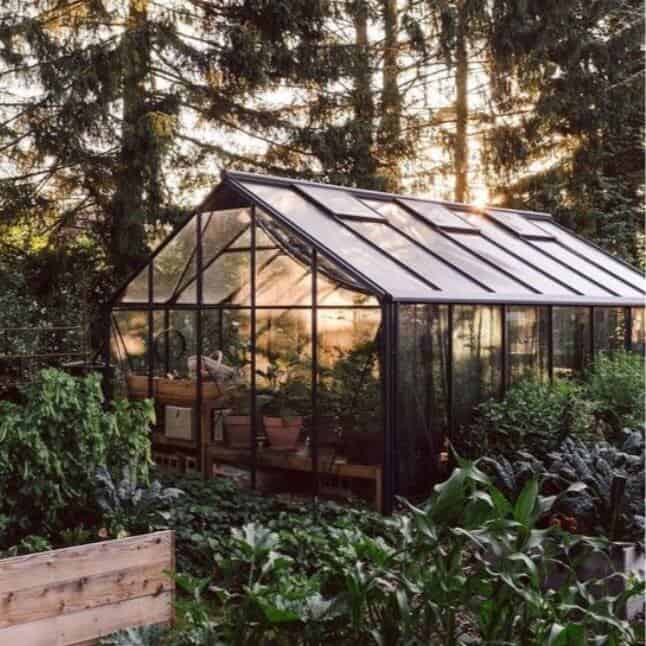
My affordable walk-in greenhouse
I own a great affordable starter Mini Walk-in Greenhouse that has 3 tiers, and 6 shelves, for indoor and outdoor use. It has everything you need to get growing right away without breaking the bank. In addition, It has a relatively sturdy construction and is made from heavy-duty powder-coated tubular steel. It can support a maximum weight of 22 lbs. You can keep anything like flower pots or seed trays on these shelves. The cover is transparent PVC. This means your greenhouse is 100% waterproof and UV protected while absorbing maximum sunlight. I love it cause it flexes slightly in the wind, and is actually light enough to move as one piece if you ever want to shift it around your yard. With that being said, it doesn’t fly away either. It’s very efficient at keeping pests and animals out while letting lots of light in to help your plants grow. If you are enthusiastic about growing large plants, you have space for that too. With some careful spacing planning (more on that in a second) you can remove shelves or use the top level for plants that will get taller and need some room. Suppose you want to do a remodel and move it indoors. Completely possible. Keep it in the kitchen, on your outdoor deck ideas, in your backyard, or anywhere you want.
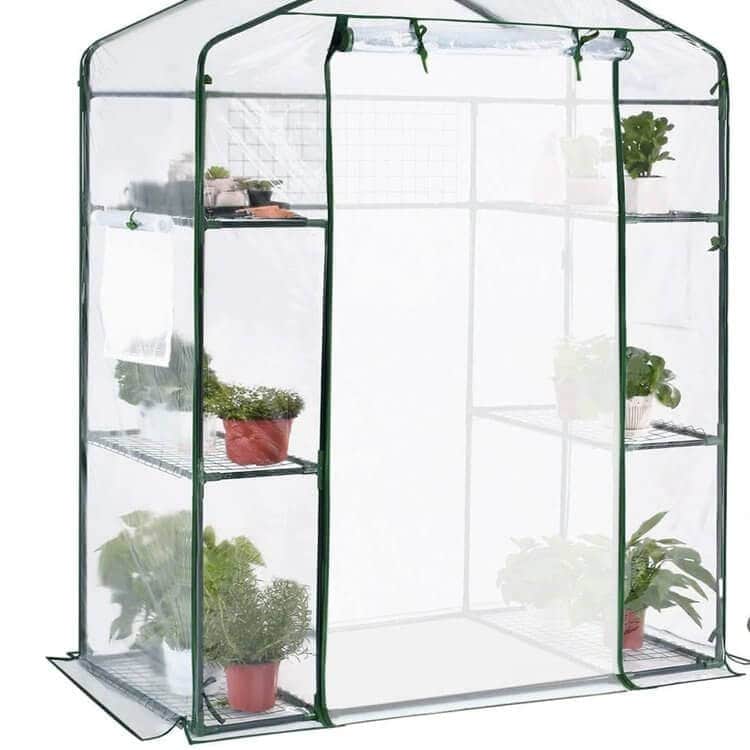
Well, now that we have seen my greenhouse, let’s look at some things that you might want to know before starting a small greenhouse.
Gardening in greenhouses

Growing plants in a greenhouse is fun and fulfilling, but it does take some consideration to ensure you get off on the right foot. But don’t worry, I got ya covered….
HOW TO GET STARTED

The first thing you will want to figure out before buying a greenhouse is how much space you need. Believe it or not, it does get crowded inside once you get going. Do a quick scan of pots and plants and make sure you have enough surface area for everything you want to grow. Also, consider what you might want to do in the future and make allocations for that. This includes things like location, planting around it, and if you want to move plants out of the greenhouse and into an outdoor garden or moveable raised beds. You should also keep in mind what plants you want to grow, like vegetable seeds or ornamental plants. After you have made up your mind on all this, there are different types of greenhouses to choose from:
Free-standing greenhouse: This is, of course, the greenhouse I am using right now. It is a stand-alone greenhouse. You can place it anywhere you want, whenever you want, as long as there is ample sunlight. You should also make sure to place it on a level surface.
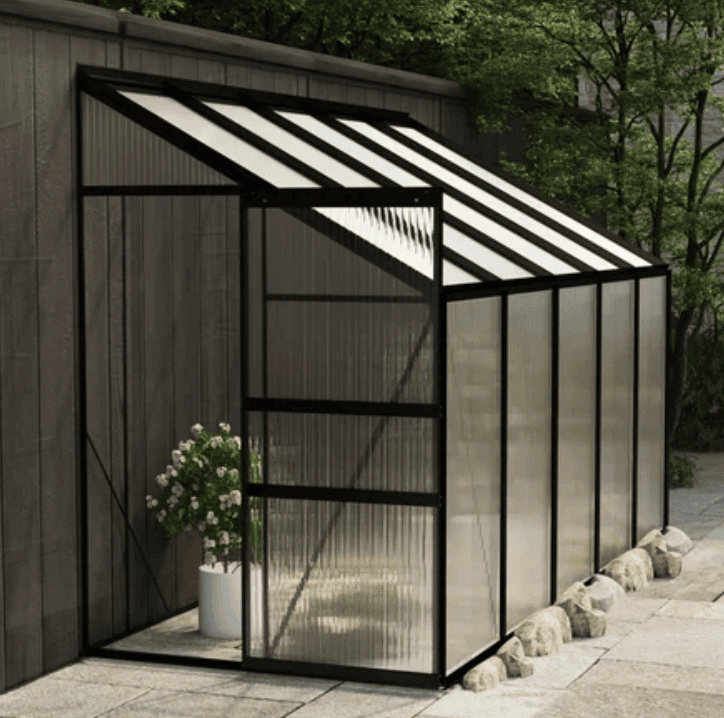
Lean-to or attached greenhouse: The major advantage of this greenhouse is that you will be attaching it to an already existing wall, so there is no need to construct all four greenhouse walls. Since the wall it is attached to is already sturdy, you can make the greenhouse walls a bit lighter. This greenhouse is an excellent choice for you if you have space constraints but still want to grow some vegetables and herbs. The only downside is that the load-bearing wall side will get no sunlight.

Mini greenhouse: Suppose you are living in a house with a tiny backyard or an apartment where you really can’t keep a greenhouse outside, then you can opt for a mini greenhouse. They come in cute styles. I like this mini greenhouse. There are ample amounts to choose from. Frames are made of aluminum or wood, and they can have polycarbonate or glass covers. Where you place a mini greenhouse depends on the weather. In winter, keep it somewhere you can get maximum sunlight. Make sure to protect it during hot summer days. You can even take this greenhouse with you when you move to a different house.
You can always make a greenhouse on your own by using inexpensive materials like clear plastic bags or sheeting as a DIY. I haven’t tackled this yet. But I will my friends. If you are looking for a great tutorial on how to make a greenhouse. Try this greenhouse DIY out.
Pro Tip: Repurpose plastic to-go containers and glass jars to hold plants in your greenhouse.
WHERE TO PLACE YOUR GREENHOUSE

Okay, you bought your new greenhouse. Good job! The next step is to place it on a flat surface and somewhere with good sunlight. Face the greenhouse towards the sun, whether it is indoor or outdoor. It is good to keep a thermometer and humidity monitor in your greenhouse so that you can keep track of the temperature. Ideally, it maintains at 85 degrees celsius during the day and just around 55 or 60 at night. But honestly, I peak and valley about 10 degrees in either direction. It’s not ideal but I haven’t had any issues. Make sure your greenhouse is not too hot or too humid. Having a thermometer will help. Try to use shade cloths when summer days are extremely hot and be sure to let the front door stay open to allow air to circulate. My mini greenhouse doesn’t have a top vent so I open the greenhouse in the afternoon to keep the temperature and humidity in range. In case you are wondering relative humidity is ideal at about 80% Also, be careful to avoid spots that are prone to frost or have the possibility of collecting cold air.
PLANTS TO GROW IN A SMALL GREENHOUSE

After buying and setting up a greenhouse, the next step is to decide on your crops. I think this is the best part! If you do not plan to spend some bucks on a heating system to maintain summer-like conditions during winters, it is good to go for seasonal crops. In summer, you can grow crops like cucumbers, peppers, tomatoes, and eggplants. During autumn, opt for collards, green onions, radishes, and Brussels sprouts. Winter is good for growing leeks, carrots, beets, and asparagus. Early spring gardening is mainly about getting a head start. You can start with hardy plants like leeks, shallots, peas, and onions. Mid-spring is the time to grow tender plants like pumpkins, melons, squash, and cucumbers.
By properly planning ahead and creating the right conditions, you can grow herbs, fruits, and vegetables in an indoor greenhouse. Carrots, avocados, mint, parsley, figs, and many other plants can be grown comfortably in an indoor greenhouse.
Pro Tip: If you are attempting greenhouse gardening for the first time, you can try some easy-to-grow plants like carrots, asparagus, spinach, and eggplants.
MAXIMIZING A SMALL GREENHOUSE
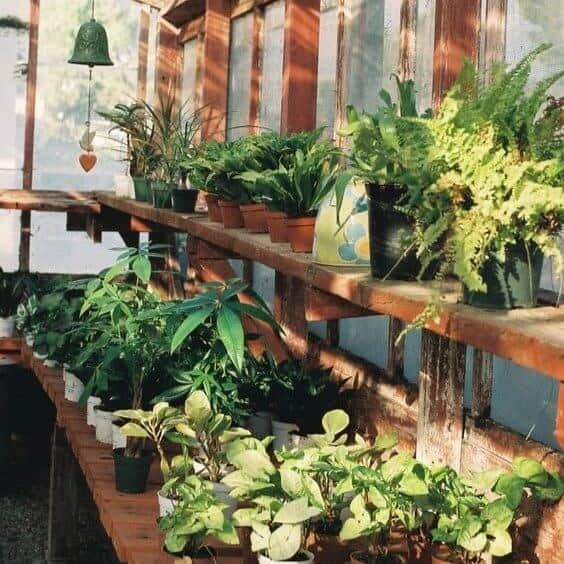
Okay, now let’s talk about greenhouse space planning. This is important to help with water usage and get you growing the most efficiently. Small greenhouses always suffer from space constraints. Follow these easy tips to help you get your greenhouse space maximized:
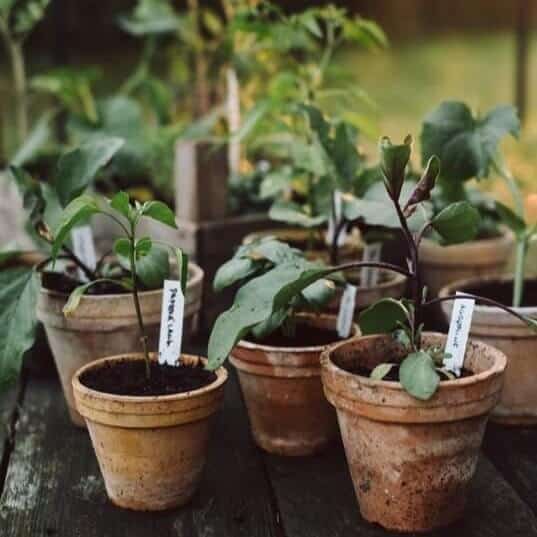
- You can use the headroom of the greenhouse by growing plants vertically with the help of planter walls and vertical garden towers. Use pot stands, hanging planters, and hooks to add beauty and space to your greenhouse. Similarly, in the case of an outdoor greenhouse with ground soil, you can grow directly on the ground. Make a little path on which you can stand to weed and water the plants. I use this potting mix for my greenhouse plants and I quickly germinate seeds in these.
- Use narrow workbenches and potting tables and place them strategically. You can also use stacked and pyramid-style beds for planting.
- Use containers to grow plants that can be placed outside during the warm season. Then this space can be used to grow some seasonal crops. I like to move plants out into the direct sun once a week or so. Plus, it’s easy to permanently harden plants and take them outside when they are already in pots.
- Place some stepping stones strategically so that you can stand over your plants and save some space.
- Water from the top down and watch the drip patterns. Place plants under drip patterns to maximize water usage and save time when watering.
- Always try to use your greenhouse at full capacity and plan your crops accordingly. Make a note of plants that can be harvested quickly. You can plant new crops there once you have harvested the old ones.
- Segregate plants based on their water and temperature needs.
- If you see pests and or mold. Move them out quickly to avoid infestation
- Drainage – I can not stress this enough. Make sure your pots all drain to avoid root rot. I installed a watering system so watering is quick and easy, and drainage is a must to avoid too much moisture collection at the roots. This is a game-changer!
HOW EFFECTIVE IS YOUR SMALL GREENHOUSE?

A small greenhouse has several advantages. It is a practical and useful alternative to traditional greenhouses.
- Since they require only a limited space, anyone can have a small greenhouse irrespective of their space issues.
- They are also extremely easy to make. Many gardeners make their greenhouses by themselves. You can also seek help from a professional if you are not sure about doing it yourself.
- When they are used for seed starting, small greenhouses are the most useful.
- If you already have a backyard and a garden, then you can use a small greenhouse to clone plants in your garden.
- You can keep bothersome pests and animals away by using a small greenhouse. Furthermore, you can also control unwanted diseases from ruining your plants.
- It is favorable financially to keep a small greenhouse. You can cut down on your grocery bill and still have fresh veggies. After the initial investment, there are not a lot of costs associated with small greenhouses.
MISTAKES TO AVOID WHILE GREENHOUSE GARDENING
When you are a newbie to greenhouse gardening, you are likely to make some mistakes. To achieve a fruitful growing season, you can avoid some common mistakes that greenhouse gardeners make:
- Ventilation: Greenhouses should have proper ventilation for the plants to grow. Lack of proper ventilation can make your plants prone to diseases, and they will easily perish. On hot summer days, the greenhouse temperature can rise drastically, cooking your plants. This can happen even during the winter months if you don’t have proper ventilation.
- Heating: The right temperature is needed to grow plants properly. This may not be much of an issue during the summer months, but temperatures and sunlight can decrease drastically during the winter. In places with harsh winters, always use a heater made specifically for greenhouses to help maintain the temperature inside them. Similarly, provide shade for your greenhouse whenever sunlight is too much.
- Humidity: Diseases can run rampant when the humidity is too high. Similarly, plants can dry out when there is too little water. Find out the optimal level of humidity for the greenhouse.
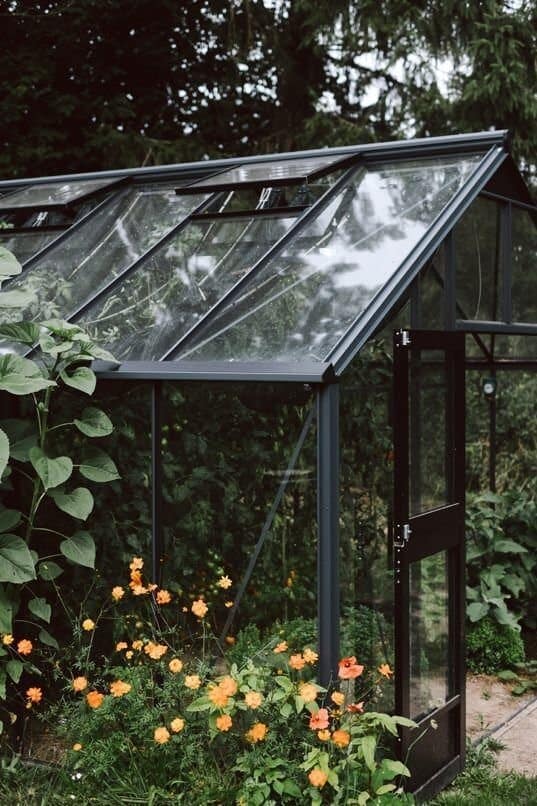
Want an upgrade?
I have been raving about my greenhouse for some time, but I am planning to upgrade it to a lean-to greenhouse. I wanted to try something easy and affordable at first. Good news? I did it and I proved to myself I can take my skills for indoor plants outdoors. I can’t wait to evolve into this larger more permanent option soon. Gardening is just so fun. This upgraded option looks super sleek and is a good greenhouse to protect your plants in cold weather with the added benefit of having a vent through the top to help regulate tempt and humidity a bit easier. In addition, the panel and frame are made of aluminum, making them extra sturdy.
Greenhouse gardening is extremely fun and relaxing, and you can always develop it into a hobby. You can even take a mini-vacation in your small greenhouse amongst your plants and have the feel of a tropical country.

